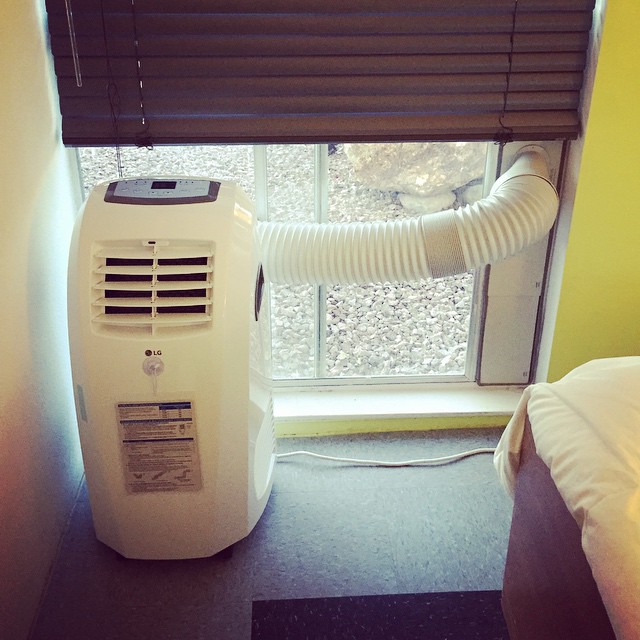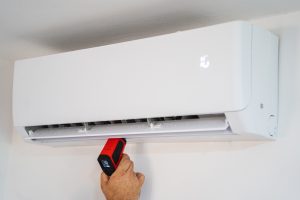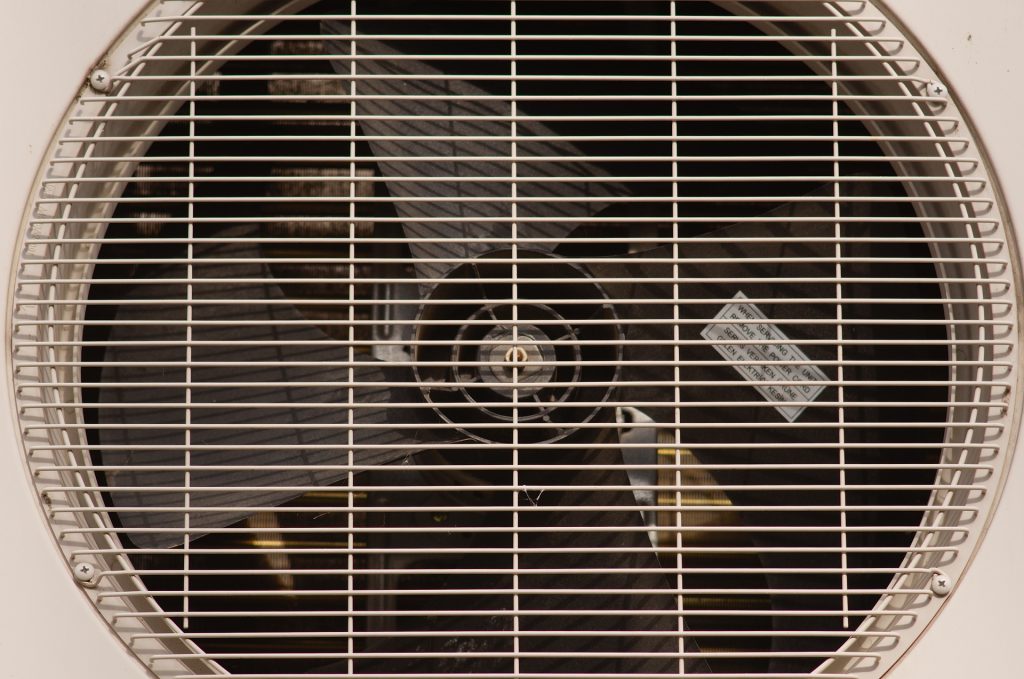Can I use a portable air conditioner in a room without a window? The straightforward answer is yes. There are many options to consider when venting a portable AC in a room that has no window. Although the procedure seems quite overwhelming, you can quickly do it when you have the right tools.
You are probably wondering, “Do portable air conditioners work without a window?” The good news is that we’ve got an answer. In this guide, you’ll learn how to vent a portable air conditioner without a window. You have nothing to worry about if your room has no window. Keep reading to learn more.
How to Vent a Portable Air Conditioner without a Window

Every portable window air conditioner requires a vent to function correctly. When turned on, the AC will suck the warm air in your room. It then cools the air and returns it to your room. Meanwhile, the air conditioner will have to exhaust the warm air.
If not vented, the air conditioner will exhaust the warm air back into your room, lowering its effectiveness to cool. You’ll end up spending a lot of money on cooling costs.
Here are the ways on how to vent a portable air conditioner without a window.
- Venting an AC through the door
- Venting an AC through the wall
- Venting an AC through the ceiling
- Venting an AC through a dryer vent
- Venting an AC through the chimney
Now, let’s see how you can keep your un-windowed room cool using the four options.
Venting an AC through the Door
Apart from venting a portable AC through the window, another easiest way to vent the air conditioner is through a sliding door. The good news is that there are kits specifically meant for sliding doors to help you vent out warm air. You can easily fit them on your doors and get your AC working.
However, the hose pipes for most portable ACs are not usually very long. So, you’ll have to place the portable air conditioner close to the door. If placed far from the door, the hose pipe might not exhaust the warm air outside. Thankfully, some portable ACs have a bit longer hose pipes.
If you feel it’s not right to place a portable AC next to your door and have a pet door in the room, you can use it to vent the AC unit. However, you must ensure that you’ve tightly sealed the area around the hose pipe’s entrance. That helps prevent the warm air from leaking back into your room.
Venting an AC through the Wall
Another best way to vent a portable air conditioner is by creating a hole through your wall. Notably, most homeowners opt to drill a hole on their walls when other options have failed. It provides a permanent solution to your portable air conditioning system.
To make a hole on your walls, you must have the right tools because it can be difficult to reverse any error you make. The size of the hole to drill will depend on the diameter of the AC’s hose pipe. Also, you need to consider the number of times you’ll use the hole to vent your portable AC.
Once you’ve drilled the hole on your wall, seal it properly to keep away dirt, insects, and other environmental irritants. The best way to seal the hole is by using silicone caulk. All you need to do is cut the hose’s tip at a 45-degree angle, place it inside a caulk gun, and apply caulk around it on the wall.
It’s no doubt that venting an AC through a wall built with stones and bricks is tough. You must be cautious about the wiring and plumbing on your wall. If you don’t have the right tools and expertise to drill a hole through the wall, consider hiring an air conditioning specialist in Phoenix.
On the other hand, drilling a hole on drywall or a wall made of wood is easy. But again, you have to consider the location of the wall you intend to drill. Your first option should be an exterior wall that can vent air directly outdoors.
Whether you are drilling a wall made of stone, bricks, drywall, or wood, you need to find the safest drilling spot. Otherwise, you might weaken the structure, especially if you drill the supporting beams or studs. The best way to find a safe drilling spot is by reviewing the building’s architectural plan.
Venting an AC through the Ceiling
If your home has a drop ceiling, you can also consider venting the portable AC through the ceiling. The drop ceilings are not available in most modern homes but are common in older homes.
To vent the AC, you have to make a hole through the ceiling panel to accommodate the hose. Ensure you don’t interfere with the pipes and electric wires running on top of your room’s ceiling panel.
Once you’ve made the hole, run the hose through it and seal the remaining openings using a silicone sealant. You have to monitor the humidity and temperature in the ceiling space to ensure that heat and humidity levels are not too high. If it’s too humid, mold will grow in the ceiling space.
However, fitting the exhaust hose on the ceiling tile requires much technical knowledge. It can be challenging for homeowners without expertise. That’s why most people opt to invest in ceiling vent kits that are easy to install. It’s the most convenient way to run a hose vent through the ceiling.
Notably, venting ACs through the ceiling is common in computer server rooms. Such areas don’t usually have windows leaving this technique the only viable option to ventilate the room.
Venting an AC through the Dryer Vent
While it’s possible to vent your portable AC through a dryer vent, most manufacturers and experts recommend against it. That’s because the size of dryer vents is usually smaller than the AC’s exhaust hose. You’ll have to apply a lot of force to insert the hose into the dryer vent.
However, many homeowners have tried this technique, and it works. If you have a dryer in your home, you also need to try this out, especially when it’s the only workable option. You just need to ensure the dryer vent’s diameter is big enough to allow warm air to pass through freely.
Before connecting the AC’s hose to the dryer’s vent, ensure the dryer can effectively get rid of hot air. Otherwise, the heat might build up in the system and cause a fire. Even after venting the AC through the dryer vent, you should continuously monitor the air conditioner and the dryer to ensure that both are running efficiently.
Venting an AC through Unused Chimney
Another effective way to vent a portable AC in a windowless room is through a chimney. You can get rid of the warm air produced in your air conditioner by piping it out through the chimney.
However, you must ensure that the chimney is not in use. For safety reasons, never try venting a portable AC through a fully functional chimney or fireplace. You’ll be exposing yourself to many risks.
If you don’t use the fireplace, consider placing the AC unit inside it, right beneath the chimney. You can then attach the vent hose inside the chimney walls to channel hot air up the chimney. You can even extend the hosepipe further up to exhaust heat efficiently.
Frequently Asked Questions
Here are some of the questions that most homeowners ask about portable ACs.
Can You Use a Portable Air Conditioner Without a Window?
Yes. For window AC insulation, most portable ACs require a window to vent out warm air, there are other options to consider when your room is windowless. You can vent out the warm exhaust air through the wall, the ceiling, the door, or the dryer vents, depending on your most convenient option.
How Long Do Portable Air Conditioners Last?
Portable air conditioners can last for ten years, on average. But when well-maintained, it can last for up to 15 years. Notably, the air conditioners are easy to install, compared to other ACs. The good news is that you can move them to cool any room in your home. You can also add an air conditioner pad to secure your AC systems from pest and molds on the floor.
Do All Portable Air Conditioners Need to Get Vented?
The straightforward answer is yes. A portable air conditioner works similarly to any other air conditioning system. It pulls warm air in a room, passes it through a refrigerant to cool, and then pumps the cold air back into the room. Meanwhile, it also has to exhaust warm air outdoors.
Notably, all portable air conditioners require a vent to exhaust the warm air. If you leave the vent hose inside the room, you’ll get cold and warm air. Consequently, it can interfere with the effectiveness of your portable AC. You’ll also use a lot of energy to cool the room.
Final Words
Now that you know how to vent a portable air conditioner without a window, you have nothing to worry about your windowless room. You can vent your AC through the wall, ceiling panel, dryer vent, sliding door, or the chimney. Compare the five options and select the most convenient one. You can also check out the average cost for to replace heating and air conditioning to prepare for your next purchase.














